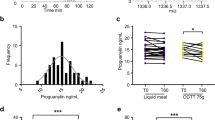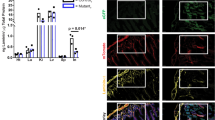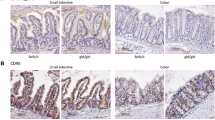Abstract
Enhancing factor (EF), a growth factor modulator, recently identified as the mouse secretory phospholipase A2 (PLA2), has been isolated in our laboratory from the intestines of mice. EF modulates the action of epidermal growth factor (EGF) by mediating an almost 2-fold increase in EGF binding in a radioreceptor assay. EF has been localized immunohistochemically to the Paneth cells of the intestine, adjacent to the proliferating stem cell population. Although very weak staining was observed in the intestines of ICRC mice (ICRC is an inbred strain of mouse developed at this Institute) as compared to Balb/c mice, the enhancing activity was not detected in the partially purified, acid soluble intestinal proteins of the ICRC strain. However, studies using polyclonal antibodies against purified EF demonstrated that EF from Balb/c and ICRC intestines are either immunologically identical or closely related to each other although, quantitatively, EF was very low in ICRC mice. RFLP studies indicated that ICRC mice carry a mutation in the coding region of the EF gene resulting in loss of the BamHI. restriction site. On sequencing, a T insertion was found at position 166 from the ATG site thereby causing a disruption in the ORF. This probably results in undetectable levels of enhancing activity. In this paper we report the molecular characterization of the ICRC mouse with respect to theenhancing factor gene
Similar content being viewed by others
References
Chomczynski P and Sacchi N 1987 Single step method of RNA isolation by acid guanidinium thiocyanate-phenol-chloroform extraction;Anal. Biochem. 162 156–159
Cormier R T, Hong K, Halberg R B, Hawkins T L, Richardson P, Mulherkar R, Dove W F and Lander E S 1997 Secretory phospholipase Pla2g2a confers resistance to intestinal tumorigenesis;Nature Genet. 17 88–91
Deo M G, Mulherkar R and Mane S M 1983 Isolation of a polypeptide that enhances the binding of epidermal growth factor;Indian J. Biochem. Biophys. 20 228–231
Desai S J, Mulherkar R, Wagle A S and Deo M G 1991 Ontogeny of enhancing factor in mouse intestines and skin;Histochem 96 371–374
Deshpande C 1996Enhancing factor: Molecular characterization of the gene, Ph.D. thesis, Mumbai University, Mumbai
Hartree E F 1972 Determination of protein: A modification of Lowry method that gives a linear photometric response;Anal. Biochem. 48 422–427
Kennedy B P, Payette P, Mudgett J, Vadas P, Pruzanski W, Kwan M, Tang C, Rancourt D E and Cromlish W A 1995 A natural disruption of the secretory group II phospholipase A2 gene in inbred mouse strains;J. Biol. Chem. 270 22378–22385
MacPhee M, Chepenik K P, Liddell R A, Nelson K K, Siracusa L D and Buchberg A M 1995 The secretory phospholipase A2 gene is a candidate for the Mom I locus, a major modifier of APCmin included induced intestinal neoplasia;Cell 81 957–966
Mulherkar R and Deo M G 1986 Further studies on the enhancing factor and its possible mechanism of action;J. Cell Physiol. 127 183–188
Mulherkar R, Desai S J, Rao R S, Wagle A S and Deo M G 1991 Expression of enhancing factor gene and its localization in mouse tissues;Histochem 96 367–370
Mulherkar R, Rao R S, Wagle A S, Patki V and Deo M G 1993a Enhancing factor a paneth cell specific protein from mouse small intestines: predicted amino acid sequence from RT-PCR amplified cDNA and its expression;Biochem. Biophys. Res. Commun. 195 1254–1263
Mulherkar R, Rao R, Rao L, Patki V, Chauhan V S and Deo M G 1993b Enhancing factor protein from mouse small intestine belongs to the phospholipase A2 family;FEBS Lett. 317 263–266
Mulherkar R, Saraf A, Wagle A S and Deo M G 1986 Purification of the enhancing factor from mouse intestines;FEBS Lett. 207 142–144
Randelia H P, Deo M G and Lalitha V S 1988 Megaoesophagus in mouse: histochemical studies;Gastroenterology 94 1243–1244
Randive K J and Kanekar S A 1963 Biological studies on a new albino mouse at the Indian Cancer Research Institute;Indian J. Med. Res. 51 1005–1014
Sambrook J, Fritsch E F and Maniatis T 1989Molecular cloning—A Laboratory manual 2nd edition (New York: Cold Spring Harbor Laboratory Press)
Wagle A S, Desai S J and Deo M G 1989 Immunohistochemical localization of Enhancing factor a novel growth modulator in the mouse intestines;Cell Biol. Int. Rep. 13 309–311
Author information
Authors and Affiliations
Corresponding author
Rights and permissions
About this article
Cite this article
Deshpande, C., Patki, V., Deo, M.G. et al. Expression of enhancing factor/phospholipase A2 in ICRC mice. J. Biosci. 24, 21–26 (1999). https://doi.org/10.1007/BF02941102
Received:
Accepted:
Published:
Issue Date:
DOI: https://doi.org/10.1007/BF02941102




